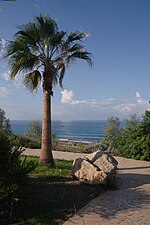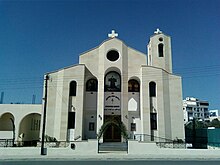Wikijunior:Asia/Cyprus

Cyprus (Greek: Κύπρος) is an island in the Mediterranean Sea that is famous for its mineral wealth, such as copper. Even the name "Cyprus" is thought to have come from the Greek word for copper "kypros".
The flag of Cyprus is a white field with a copper-orange outline of the island in the center. Two olive branches reside below the outline to support it. The white field represents peace that corresponds to the peaceful coexistence of the nation's two primary ethnic groups, the Greek Cypriots and the Turkish Cypriots. The olive branches represent peace as well, with each branch representing each group.

During the Bronze Age, Greek settlers arrived onto the island in masses. Before the 1500s/1600s, the island went through periods of rulings under the Neo-Assyrian Empire, the Persians, Alexander the Great, Ptolemaic Egypt, the Roman Empire, and the Byzantine Empire. Cyprus was under Byzantine rule for nearly 1,000 years! Afterwards, the Ottomans forcefully and violently took over Cyprus and ruled the island until 1878. The British ruled over Cyprus until 1960, following a number of agreements. Tensions between the Greek Cypriots and Turkish Cypriots flared up and got so bad that the Turkish army had to rule over northern Cyprus. This caused for ethnic divide, which is evident to this day.
Cypriot Pound / Euro Pound is the currency used in Cyprus and Nikos Christodoulides is the 8th and current president of Cyprus (since February 2023).
Where is Cyprus?
[edit | edit source]

Cyprus is an island country located in the eastern Mediterranean Sea. It is located located south of Turkey, west of Syria and Lebanon , northwest of Israel and Palestine, north of Egypt, and southeast of Greece. Nicosia is the capital city of Cyprus
The island is divided into two parts: the Republic of Cyprus, which is recognized by most countries, and the Turkish Republic of Northern Cyprus, which is only recognized by Turkey.
How many people live in Cyprus?
[edit | edit source]
According to a 2023 estimate, the population of Cyprus stands at 1.3 millin people. This number is compromised of 98.8% Greek and the remaining population accounts for Armenians and Turkish Cypriots.
There are two main ethnic groups on the island: the Greeks and the Turkish. The Greek Cypriots, who make up most of the population, come from a mix of aboriginal inhabitants and immigrants from the Peloponnese people (Greek island), who controlled Cyprus from 1200 B.C..
The Turkish Cypriots come from the Ottoman Empire, who controlled the island in 1571, and immigrants from Anatolia - brought in by the sultan's government.
What are the most common languages in Cyprus?
[edit | edit source]

Both Cypriot Greek and Cypriot Turkish are the most common languages used in Cyprus, but Cypriot Greek is used by the government, courts, administration, media, and educational institutes.
What is the most common religion in Cyprus?
[edit | edit source]Although there seems to be no official census on this, we can report that most Greek Cypriots are Eastern Orthodox Christians and Turkish Cypriots are Sunni Muslims. 73% of the island's religious makeup consists of Christians.
The Church of Cyprus is autocephalous (not under the authority of any religious leadership). During the Ottoman ruling, the archbishop of the Church of Cyprus was made responsible for the secular and religious domains of the Orthodox cummunity and was, subsequently, given the title, ethnarch.

There are also smaller Maronite, Armenian, Roman Catholic, and Anglican Christian communities on the island.
What is the sport of Cyprus?
[edit | edit source]
Cyprus rallies are the most attractive athletic event in the country, with thousands of dedicated fans watching them. Cyprus hosts a big rally racing event every year and has been held annually since 1970. The event is part of the World Rally Championship (or the WRC). The rally is held in September on the largest mountain range in the country: the Troodos Mountains.
The rally is a three-day event, with each day providing a number of entertaining stages. A stage lasts for a certain amount of time and is between 10-30 km long (6.2 to 18.64 miles long). The stages take place throughout the island and feature different geographical intensities, including gravel, asphalt and snow. The Cyprus Rally is a challenging rally for both drivers and the cars. The roads are often narrow and twisty, and the weather can be unpredictable.
Football, or soccer, is the most popular sport in Cyprus.
What are some important sites?
[edit | edit source]
St Hilarion Castle is named after a Catholic monk named Hilarion. who fled persecution from the 'Holy Land' (Palestine region). He remained in a mountain cave that overlooked the Kyrenia plain, protecting the pathway between the coast and Nicosia (or Lefkosia). In the 10th century, the Byzantines built a church and monastery over Hilarion's tomb. Due to the site's strategic position, it was used as a watchtower and beacon during warfare against the Arabs in the 7th and 8th centuries. The castle was also an important mean of communication between Buffavento Castle and Kantara Castles, which were situated further east. St Hilarion Castle is made up of three parts: a lower & higher defensive wall (or enceinte) and a tower (named Prince John’s Tower). Through the staircase, one is able to see a breathtaking view of not only Kyrenia, but (on good days) mainland Turkey!
Ancient Kourion, also known as "Curium", is an archaeological site in Lemesos. It is built on a hillside, with a sweeping view of the surrounding patchwork fields and the sea. It houses the Christian basilica, the house of Eustolius (an ancient Roman bath that displays ancient mosaics, including various Christian symbols and text), the house of the Gladiators (so named because some of its mosaics depict gladiatorial battles) (so named because some of its mosaics depict gladiatorial battles), some northern plateau ruins and a Roman theater that used to hold up to 3,500 spectators.

Tombs of the Kings is quite an intriguing name! Located in Pafos, Cyprus (western Cyprus), the underground tombs are said to have been made during the Hellenistic and Roman period. These are made out of plain, solid rock. Some tombs are decorated with Doric columns and frescoed walls. Many tourists say that tomb #3 is the best one because of its underground court (or atrium). Surprisingly, these tombs actually do not host kings - but other high-ranking officials. Due to the sophisticated build, the UNESCO World Heritage site (since 1980) was given the monstrous name. These tombs are eerily similar to the ones you may see in Alexandria, Egypt.
 |
Wikijunior:Asia | edit | |


